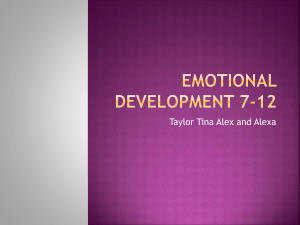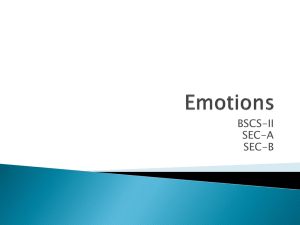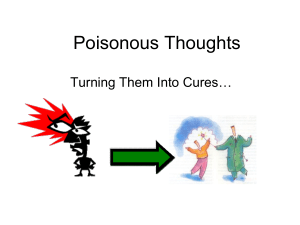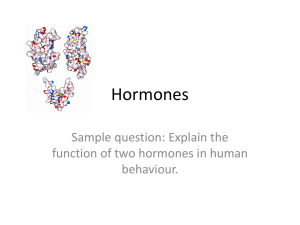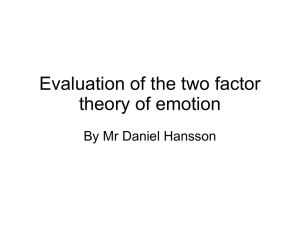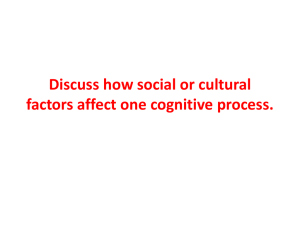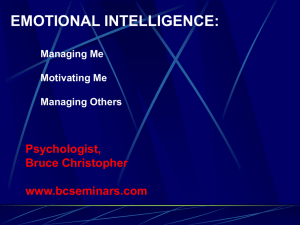100 words extension Writing ~~ Beyond Basic
advertisement
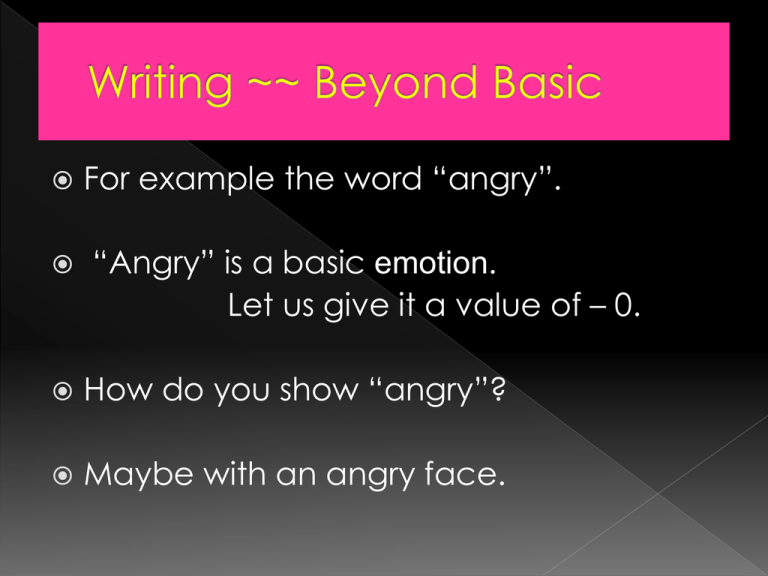
For example the word “angry”. “Angry” is a basic emotion. Let us give it a value of – 0. How do you show “angry”? Maybe with an angry face. A basic understanding of children’s learning is an essential for a teacher. By using a systematic approach you can integrate may methods to achieve a goal. Children have the same needs as adults when learning something new. They need visual stimulation as well as physical touch. By putting these together we teach sensory words. One of the key factors in learning English is the value of words to use. When we teach we need to teach the emotional values. This means that when we teach a value we must add the action and reaction to the learning cycle. For example the word “angry”. “Angry” is a basic emotion. Let us give it a value of – 0. How do you show “angry”? Maybe with an angry face. Now let us take some time to think of other words for “angry”. How about “hate”. What value does “hate” have? It has a high emotional value. How about a less emotional word for “angry”. Let us try “disagree”. This is a long word for the kindergarten but should be ok for the mid-elementary. So we have a basic and more advanced vocabulary from one word. Often miscommunication is about lack of vocabulary. The wrong word can add fire or kill the fire of this problem. Once children learn to, not only memorize but conceptualize the core word they can branch out into more of the same idea expressing different levels of emotion. Write down “Angry, Hate, and Disagree” on different cards. Say them with your voice first. Each with a different emotional value. Repeat this with the children. Make sure they change their voice and emotion with each one. We have now helped the children to express themselves with one word. We have also added an emotion to be connected with the word. Did you write your words on the same color of paper? Emotions need color. Red is for high etc. Color is also important to children’s learning. They will remember color better than words. By connecting words with color you add to the learning process for later. Now we have three words, emotions, and colours. Now let us make a simple sentence. I hate you. I am angry with you. I disagree with you. Each sentence is different. This matches the difference in the word and emotion. If we make the same sentence we confuse the child in connecting the three. Have the children repeat the sentence with you with the complementing emotion. Now the children have a sentence to focus on with the emotion and the word. We want to make a drama script. Think about 3 relationships that can make your student angry, disagree, or hate. Make each one into a scene with the strongest first. “hate” In English we want to learn the high to low emotion, or red to blue colour sequence and connect them to a real idea. Let us make the scene with hate. Introduction Scene 1 You showed your friend a toy and they won’t give it back. Question to children is your emotion high or low? Now write each scene. Jane – Look at this new toy (Kind) + I got for Christmas (higher) + from my mother. (higher) Kelly – Wow it is so nice. (kind) + May I hold it? + It is so soft. Now let us take some time to think of other words for “angry”. How about “hate”. What value does “hate” have? It has a high emotional value. How about a less emotional word for “angry”. Let us try “disagree”. This is a long word for kindergarten but should be ok for the mid-elementary or higher. So we have a basic and more advanced vocabulary from one word. Often miscommunication is about lack of vocabulary. The wrong word can add fire or kill the fire of this problem. Once you learn to, not only memorize but conceptualize the core word they can branch out into more of the same idea expressing different levels of emotion. Write down Angry, Hate, and Disagree on different cards. Say them with your voice first. Each with a different emotional value. Repeat this with the student. Make sure they change their voice and emotion with each one. We have now helped the student to express themselves better from one word. We have also (+) added an emotion to be connected with the word. Did you write your words on the same color of paper? Emotions need color. Red is for high, etc. Color is also important to our learning. We will remember color better than words. By connecting words with color you (+) add to the learning process for later. Now we have three words, emotions, and colours. Now let us make a simple sentence. I hate you. I am angry with you. I disagree with you. Each sentence is different. This matches the difference in the word and emotion. If we use the same emotion in each sentence we confuse the student understanding. Have the student repeat the sentence with you with the complementing emotion. Now the students have a sentence to focus on with the emotion and the word. We want to make a drama script. Think about 3 relationships that can make your student angry, disagree, or hate. Make each one into a scene with the strongest first ~~ “hate”. In English we want to learn the high to low emotion, or red to blue colour sequence and connect them to a real idea. Let us make the scene with hate. Introduction Scene 1 You gave your friend a toy and they won’t give it back. Ask the student about their emotion. Is their emotion high or low? Now write each scene. Jane – Look at this new toy (Kind) + I got for Christmas (higher) + from my mother. (higher) Look at this new toy I got for Christmas from my mother. Kelly – Wow it is so nice. (Kind) + May I hold it? (lower) + It is so soft. (lower) Wow it is so nice. May I hold it? It is so soft. ~~ Follow the idea of keeping the toy from the original child. ~~ Use at least three (3) different categories of words in EACH SENTENCE. ~~ Remember to choose the words that show the correct emotion and good grammar.
